The Samsung Galaxy S6 and S6 edge Review
by Joshua Ho on April 17, 2015 9:00 AM EST- Posted in
- Smartphones
- Samsung
- Mobile
- Galaxy S6
- Galaxy S6 Edge
NAND Performance: The First UFS Phone
Storage performance is often a critical area for user performance, as applications cannot be cached in RAM at every possible moment. Camera performance is also often limited by storage performance as RAM buffers can only do so much to maintain performance before it’s necessary to commit photos to non-volatile storage.
However due to the memory hierarchy to some extent, storage performance is often hard to notice once it’s at a point where things are “good enough”. Unfortunately, in some cases we can see OEMs failing to include sufficiently performant solid-state storage, which can be a major pain point in the user experience when random read/write performance is low enough that there are noticeable IO pauses as the system has to wait for data to be loaded from storage.
The Samsung Galaxy S6 family is the first shipping implementation of UFS (Universal Flash Storage) 2.0 standard, which makes the internal storage model less like an SD card in nature. When comparing the eMMC 5.1 standard to the UFS 2.0 standard, we see a move from a the 400 MB/s maximum of the eMMC 5.1 standard with HS400 physical link interface to MIPI M-PHY, which allows for a theoretical maximum of around 720 MB/s and should be more efficient in transmitting data than the current eMMC standard. In addition, UFS makes it possible to do full duplex communication, which means that reads and writes can happen simultaneously. There's also a command queue, which helps to avoid inefficiencies that could arise from waiting for commands once a command has been processed by the storage controller, and utilizes the SCSI protocol to facilitate these new features at the interface level.
As for the Galaxy S6 itself, the UFS implementation Samsung is using is Samsung developed. Samsung's current implementation only supports up to 300 MB/s (or 2.4 Gbps) transfer rates as a theoretical maximum, so from an interface perspective it's still not reaching the full capabilities of the standard. Though even at a cap of 300MB/sec, it still stands to be a significant improvement over typical eMMC solutions.
Finally, on a technical note, the 32GB models are of the model KLUBG4G1BD-E0B1 with a maximum queue depth of 16.
In order to test storage performance, we use Androbench with some custom settings to get a reasonable idea of performance in this area, although this test isn’t an exhaustive examination of storage performance by any means.
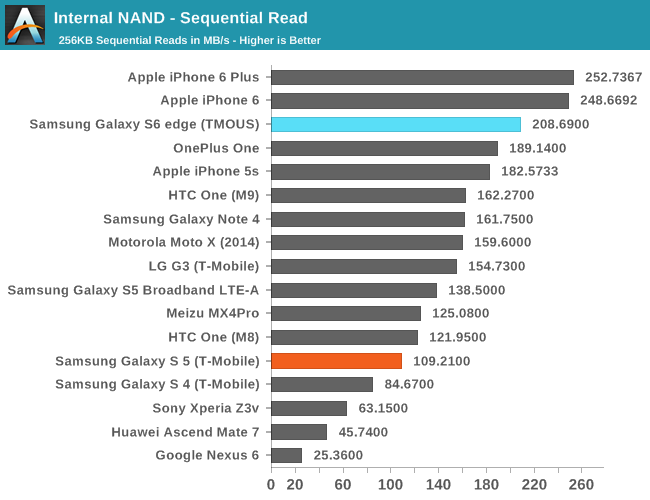
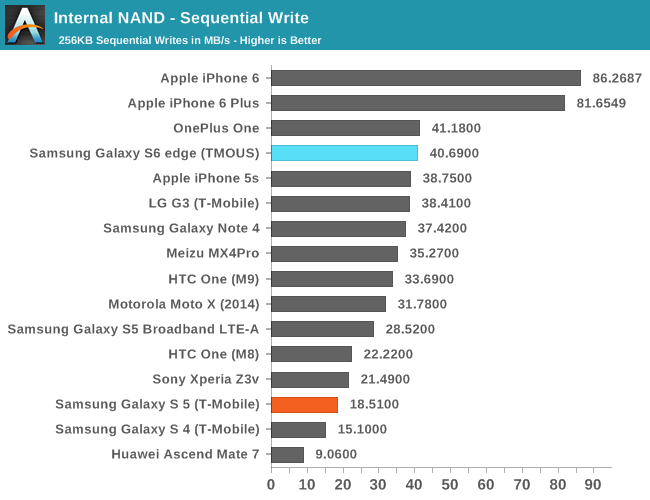
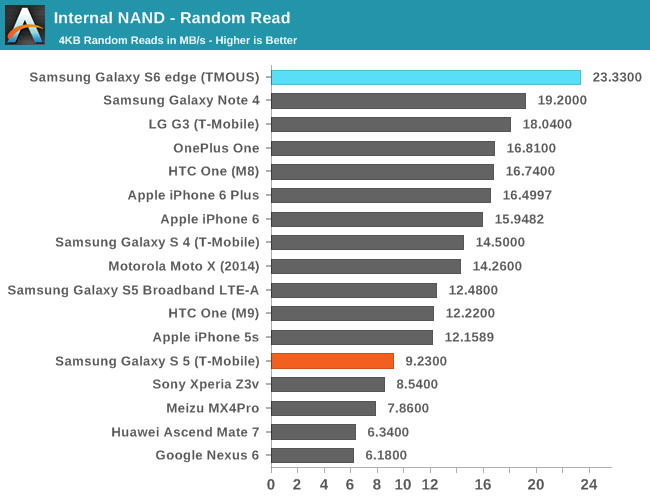
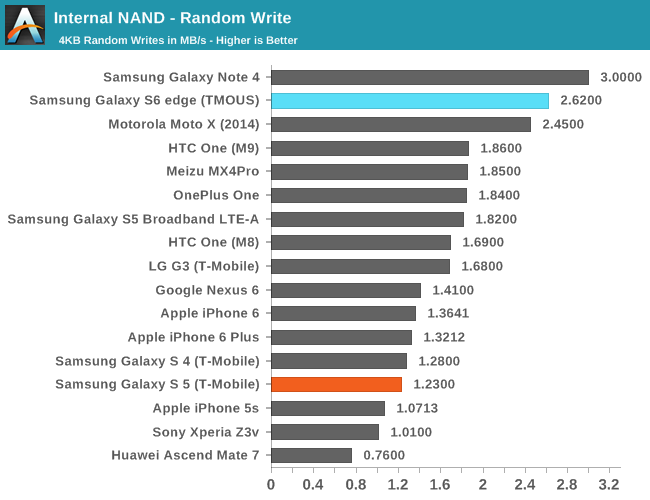
The Galaxy S6 performs rather impressively in our standard storage test, but not as fast as one might have hoped. This is due to the nature of the Androbench 3.6 test, which only tests a single IO thread, which won’t use the UFS storage of the Galaxy S6 to its full extent. In order to see the kind of difference that UFS really makes, I ran the same test again on Androbench 4.x, which does support multiple IO threads. However, as our iOS storage test and Androbench 3.6 don’t support more than a single IO thread we will continue to present both results for now.
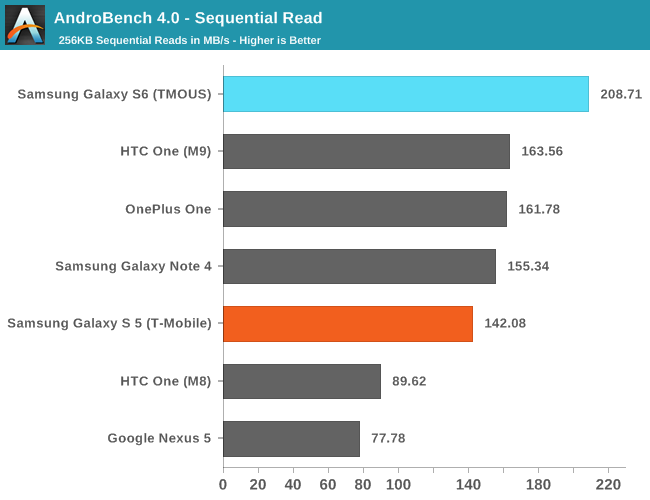
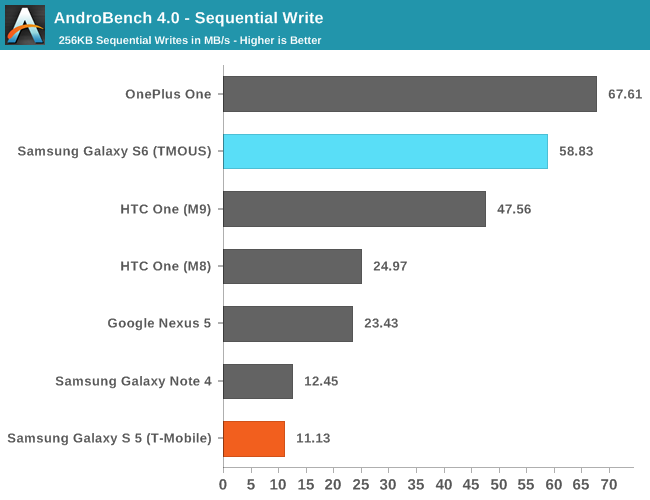
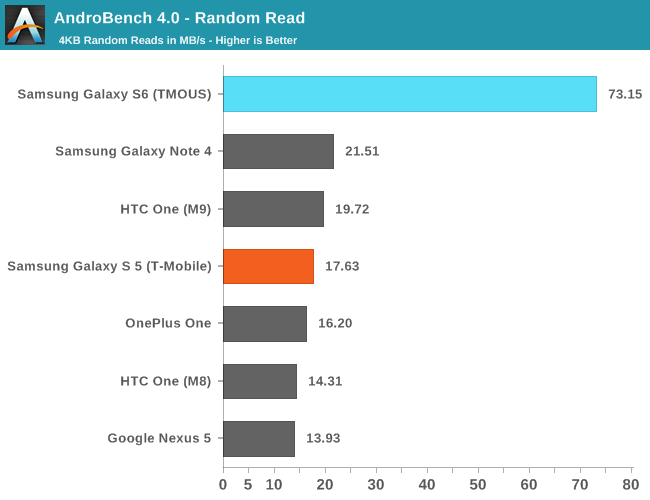
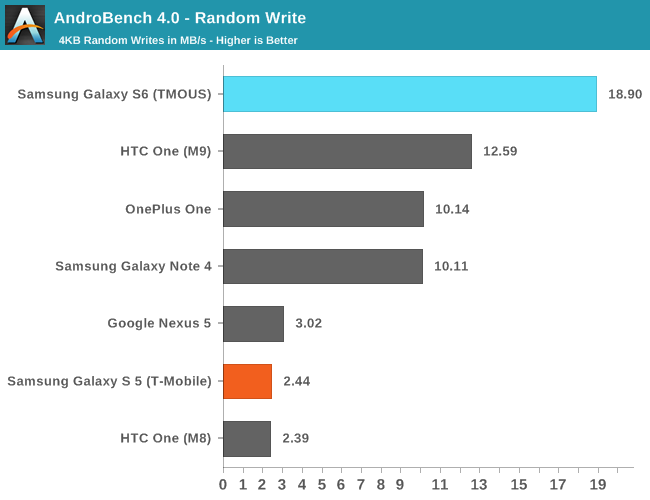
Overall, there are some immense benefits in storage performance here, especially in random IO performance. The Galaxy S6 has some of the fastest storage available in a phone today as far as I can tell given that this is basically a pure MLC solution, and shouldn’t have any real issue with storage performance holding back the rest of the phone over the course of 1-3 years as long as a reasonable amount of free space is kept to allow efficient storage management.


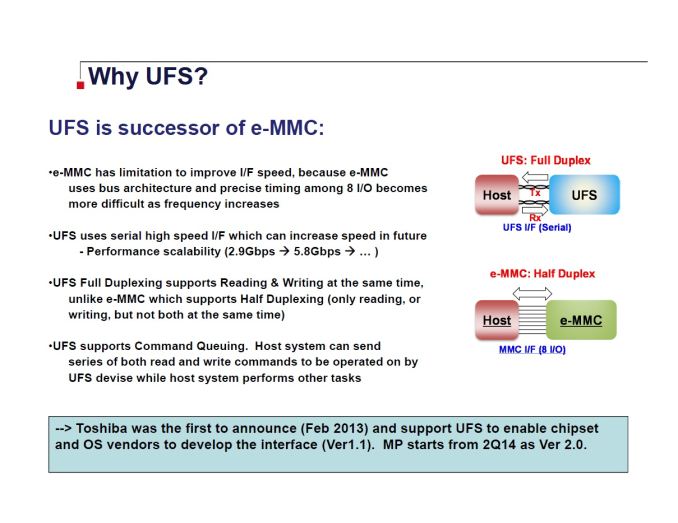








306 Comments
View All Comments
stbutt - Sunday, April 19, 2015 - link
Wow. What an amazing review that was. I am astonished at how in depth and impartial it is. Congratulations to Mr Joshua Ho and ANANDTECH.watersb - Monday, April 20, 2015 - link
Excellent detail. No way to exhaustively evaluate this decice in a single review, but this is the best I've seen. I read every word. Thanks!jasonjason - Monday, April 20, 2015 - link
s6 edge is not in-cellUser.Name - Monday, April 20, 2015 - link
Am I the only person that holds onto a smart phone for more than 18-24 months?I really dislike the trend of smart phones becoming more and more "disposable" items.
For my own requirements, they're honestly at the point now that they're fast enough, the screens are good enough, and I don't use the camera enough (I carry around a Sony NEX) that I could buy any of the high-end phones like this or an iPhone 6 and stick with it for the next five years. Storage is the only thing which I am constantly limited by.
Yes, you now have the option of a 128GB phone - well my music library alone is more than a terabyte in size. Now I don't *need* to carry my entire music library on my person at all times, but it would be nice if I could.
When you consider that a phone is also storing apps, games, photos, videos and other data, even 128GB is not a lot of storage. I may only have 30GB or so left over that I can dedicate to music after all that - which means that I'm better off still carrying around an old 160GB iPod. What I want more than anything is a phone which can finally replace that.
With a MicroSD slot, you can dedicate all of that storage to media. 64GB MicroSDXC cards are dirt-cheap right now, 128GB are a bit more expensive, and they currently top out at 200GB.
Well several years from now there may be 256GB, 384GB and 512GB cards available at the same prices 64/128/200GB cards are today.
The SDXC standard supports up to 2TB, so theoretically you could have that much storage in any phone with a MicroSDXC slot if such a card were ever released.
It just seems short-sighted to remove the MicroSD slot.
sevin7 - Monday, April 20, 2015 - link
Your battery will likely need replacing before 5 years... having to ship you're phone off for a replacement battery is just as bad as the storage problemUser.Name - Wednesday, April 22, 2015 - link
I actually mentioned a replaceable battery in my initial draft, intending to shuffle it to the end of the post, but I must have removed it instead.I completely agree, a replaceable standard battery is an important thing to have.
While I have done it, I don't want to have to disassemble a phone to replace the battery, and swap it out with a third-party one of questionable quality/safety standards.
Gorgenapper - Wednesday, April 22, 2015 - link
Micro SD cards are not as reliable as the internal flash memory (and obviously not as fast). I experienced this first hand when I went on vacation last summer and used my Samsung GS4 Active to take pics and videos. On the second night, I powered the phone off and swapped the batteries, and found that all the pics / videos I took for that day were gone, even though they had been showing in QuickPic when I got back to the hotel before powering the phone off.The micro SD card (Sandisk UHS-10 64gb) had gone into failsafe read-only mode due to failure. I had to connect to the WiFi every night and back my stuff up to Google Drive.
User.Name - Wednesday, April 22, 2015 - link
Perhaps I have been fortunate, but as long as I have paid for quality cards and checked that they are genuine (there are a lot of fake SanDisk cards out there) I have yet to have one fail on me. And moving to a read-only state is a pretty good failure mode if you ask me.But I don't think that MicroSD should *replace* the internal storage. That's why I want a phone with 128GB—or more—internal storage in addition to a MicroSD slot, so that the MicroSD is only used to store media.
I just want the option of having my phone replace the need for carrying around an old iPod. I don't plan on using MicroSD for running apps, or making up for the fact that the phone itself only has 8GB of storage.
der - Tuesday, April 21, 2015 - link
I missed this review. Are you KIDDING ME Anandtech!sonicmerlin - Tuesday, April 21, 2015 - link
You failed to mention there's a maddening delay when you use Samsung's replacement for "Ok, Google" voice activation features. They disabled the standard Google activation and replaced it with their inferior version.